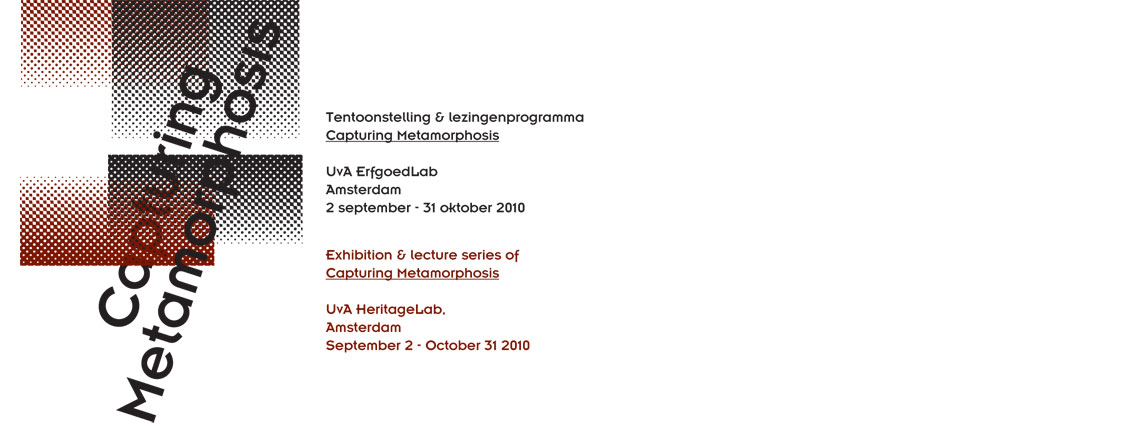14 Ocober 20.00 hrs, Nina van Leerzaal, Oude Turfmarkt 129 (Allard Pierson Museum/Bijzondere Collecties)
reservations: capturing.metamorphosis@gmail.com
The Elusive Instant of Metamorphosis - Françoise Frontisi-Ducroux (in French with English translation)
In order to understand how the ancient Greeks perceived metamorphosis, we need to consider texts and images. In vase paintings depicting myths of metamorphosis, the very process of transformation is not represented. One might think that this is due to the nature of the still image. Supposedly, only cinema can show us the progression of stages of a change in shape. However, ancient Greeks texts show that the change in category, mostly from human to animal, is simply stated as a sudden event without any transition. Conversely, the Latin poet Ovid describes different stages of metamorphosis from a temporal perspective. This approach reveals a different mode of understanding time and the difficulty the ancient Greeks faced in analysing duration. Besides their peculiar charm, Greek myths of metamorphosis are interesting in their figurative and narrative versions, because they reveal aspects of the ancient Greek categories of the mind and collective imagination.
Francoise Frontisi-Ducroux is an Hellenic expert, Agregee de Lettres Classiques, Docteur d’Etat, and Honorary Deputy Director at the College de France, as well as a team member of ANHIMA (formerly Centre Louis Gernet d’Etudes Comparees sur les Societes Anciennes (EHESS/CNRS)). She is the author of Dedale. Mythologie de l’artisan en Grece ancienne (Paris: Maspero, 1975; new edition, La Decouverte, 2000). La cithare d’Achille (BQUCC, 1, Rome: edizione de l’Ateneo, 1986). Le dieu-masque. Une figure du Dionysos d’Athenes (La Decouverte-Ecole de Rome, coll. “images a l’appui”, 1991). Du masque au visage. Aspects de l’identite en Grece ancienne (Paris: Flammarion, 1995). Dans l’oeil du miroir, with J.-P. Vernant (Paris: Odile Jacob, 1997). Les mysteres du gynecee, with P. Veyne and F. Lissarrague (Paris: Gallimard, 1998). ABCedaire de la Mythologie grecque et romaine (Paris: Flammarion, 2002). L’homme-cerf et la femme araignee (Paris: Gallimard, 2003). Ouvrages de dames, Ariane, Helene, Penelope (Seuil, 2009).
What Does It Mean to Change Change? Towards an Ontology of Metamorphosis - Boyan Manchev
According to what Foucault called an “ontology of actuality”, forms-in-transformation are at the heart of contemporary modes of production and exchange. At present, the social world is no longer a world in transformation, but a world of transformation. Within such a perspective, contemporary art, and especially performance art, play a pioneering role. They foster new forms of metamorphosis, to be appropriated and used as a structural matrix by global, economic circuits. Paradoxically, this process of transformation entails a crisis in the idea of transformationist praxis – we live in a ‘post-transformationist’ world. Thus, today’s crucial question has become one of a transformation of transformation. But what does a transformation of transformation, or a metamorphosis of metamorphosis, mean? Several examples from the field of contemporary art, and – in particular – Deufert & Plischke’s concept of ‘metabolism’, will provide the basis for examining this question.
Boyan Manchev (1970) is a philosopher and cultural theorist, teaching at the New Bulgarian University, as well as Visiting Professor at the Sofia University and the Universitat der Kunste, Berlin. He is a former Programme Director and Vice-President of the International College of Philosophy in Paris. His current research is focused within the fields of ontology, philosophy of art and political philosophy. Recent publications include: L’alteration du monde: Pour une esthetique radicale (Paris: Lignes, 2009); La Metamorphose et l’Instant – Desorganisation de la vie (Paris: La Phocide, 2009); Rue Descartes 64: La metamorphose, edited by B. Manchev (Paris, PUF, 2009); Rue Descartes 67: Quel sujet du politique?, edited by G. Basterra, R. Ivekovic and B. Manchev (Paris, PUF, 2010); The Body-Metamorphosis (Sofia: Altera, 2007).





